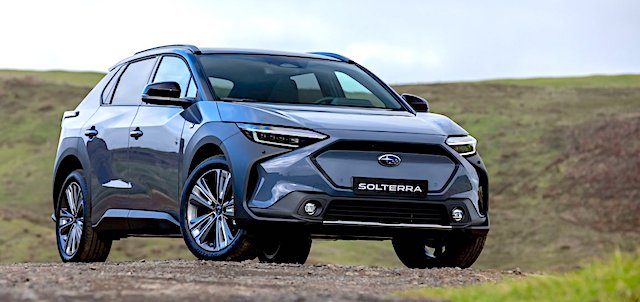
Hang on a sec! Seems there’s no place for Subaru’s trademark Eyesight safety system in the Solterra, the Japanese company’s first battery-electric vehicle (BEV).
The only thing the people from Subaru NZ will say about Eyesight’s absence from the list of safety items in Solterra is that they can’t say anything about Eyesight’s absence from the list of safety items in Solterra.
Why? Because Eyesight has been replaced in the Solterra by a suite of stuff called ‘Subaru Safety Sense’. It’s pretty much Eyesight by another name, but for the Solterra alone. Why? Because Solterra is largely a product by major Subaru shareholder Toyota, and Toyota’s safety system is called ‘Toyota Safety Sense’.
Solterra shares its all-electric platform and major components with Toyota’s first BEV, the curiously named bZ4X. It is the e-TNGA platform, or Toyota New Global Architecture. Only it’s called the e-Subaru global platform in the Solterra. Of course there are styling differences between the Solterra and bZ4X, especially front and rear.
Subaru and Toyota agreed in 2019 that Toyota would build both carmakers’ first BEV. It was the other way round on the last project between the two, back in 2005. That was the start of the planning for the two-door, rear-drive Subaru BRZ/Toyota 86, based on a modified Subaru Impreza platform.
Subaru parent Fuji Heavy Industries (FHI) built both cars. They were near-identical twins, apart from bits and pieces here and there. Both used a 147kW/205Nm flat-four 2.0-litre Subaru engine with Toyota direct-injection and six-speed Toyota manual gearbox. The automatic option was a six-speed Aisin unit.
Production was based on the relative strengths in the automotive world of both carmakers: accordingly, FHI made 12 Toyota 86s for every 1 Subaru BRZ. About 18 months after the 86 landed in New Zealand, Toyota had sold 417 models. At the same stage Subaru had sold 31 BRZs.
Soon after Subaru NZ boss Wallis Dumper made the BRZ a factory-order-only proposition. “To think of the BRZ as competition for the Toyota 86 was too challenging,” he said in September 2013. “We have made the BRZ a special-order model because we want to protect the customers who have them. If someone wants one we will get it.”
Dumper is hardly likely to find himself in the same situation with the Solterra. But whether production of the bZ4X/Solterra will mirror that of the 86/BRZ ratio is not known. Both the Solterra and bZ4X aren’t due in New Zealand until next year.
Subaru has been showing a left-hook Solterra to selected audiences in NZ, part of an attempt to gee-up early interest in the car. A pre-production right-hand drive example will do the rounds of Subaru dealerships later in the year, before Solterra officially launches here in the first half of 2023.
Whether it will have a panoramic glass roof or the optional closed-in roof with solar panels to charge the car’s auxilliary systems is not yet known. What is known is that Solterra is the first of more Subaru EVs and hybrids as the carmaker moves to slow production of pure petrol engines and cut C02 emissions by 90% by 2050.
Solterra will be equipped with Subaru’s X-Mode all-wheel drive (AWD) system. It’s an electric version, because, unlike the rest of the petrol-powered Subaru fleet, there is no mechanical driveshaft connecting front and rear axles. X-Mode comes with something called Grip Control, which is essentially a cruise-control mode to further stabilise the car over demanding surfaces.
What makes the AWD Solterra go is a 71.4kWh lithium-ion battery pack on 355-volt architecture. It delivers a maximum 160kW/335Nm via two 80kW electric motors, one on each axle. The battery comes with eight-year warranty and, says Subaru, will retain 90% of its efficiency after 10 years.
Maximum range on paper is around 460km, based on the Japanese WLTA (Worldwide Harmonised Light Vehicles Test Procedure) cycle. Expect real-world driving range to be closer to 360km. Maximum charge speed is 150kW, good for an 80% boost to the battery in about 30 minutes on a hyper charger. Nothing yet on the onboard 6.6kW charger’s performance when plugged into an at-home smart charger.
Solterra is 4690mm long, 1860mm wide, and 1650mm high. Its dimensions sit between the Forester and Outback, and its 210mm ground clearance is within a whisker of both stablemates. Dumper hopes to bring in two models: one below the government’s $80,000 Clean Car ceiling to qualify for the $8250 discount, the other a premium example above it.
- In September 2019, Toyota increased its shareholding in Subaru from 16.8% to 20%. In a further strengthening of their partnership, Subaru last year bought almost 9 million shares in Toyota for US$675m, or NZ$1.08b. Solterra is latin for ‘sun’ (sol) and ‘earth’ (terra). bZ4X is Toyota speak for ‘beyond zero’ emissions (bZ) and ‘compact crossover’ (4X). The Subaru BRZ was B for boxer engine, R for rear drive, and Z for zenith. The Toyota 86 name came from code for the original rear-drive Corollas.



